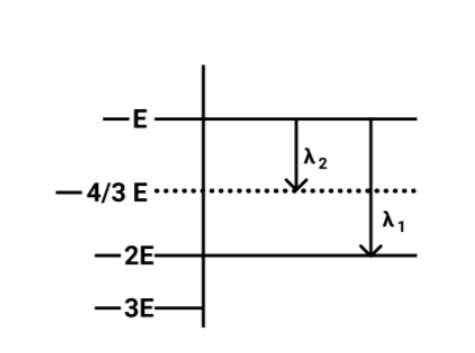
Some energy levels of a molecule are shown in fig. The ratio of the wavelengths

Answer
146.7k+ views
Hint: we have been given two wavelengths and here are the two transitions. So assuming the corresponding two these two transitions, there is the emission of photons in each case. So firstly we will find the energy of that particular photon then using the relation which we have given in the formula, we will find the ratio between these two wavelengths.
Formula used
The energy of photons,
Here,
Complete Step By Step Solution: As we know the formula for the energy of the photon and it can be written as
And from here,
And hence we can say that
Now from the figure,
The energy of a photon of wavelength
On solving the above equation, we get
Now we will calculate the Energy of the photon of wavelength
On solving the above equation, we get
So now we will calculate the ratios between the two energies
Therefore, it can be written as
Now on substituting the values, we get
So we will solve the final above equation to get the required ratios
Therefore, the option
Note: According to Einstein's equation
Formula used
The energy of photons,
Here,
Complete Step By Step Solution: As we know the formula for the energy of the photon and it can be written as
And from here,
And hence we can say that
Now from the figure,
The energy of a photon of wavelength
On solving the above equation, we get
Now we will calculate the Energy of the photon of wavelength
On solving the above equation, we get
So now we will calculate the ratios between the two energies
Therefore, it can be written as
Now on substituting the values, we get
So we will solve the final above equation to get the required ratios
Therefore, the option
Note: According to Einstein's equation
Recently Updated Pages
How to find Oxidation Number - Important Concepts for JEE

How Electromagnetic Waves are Formed - Important Concepts for JEE

Electrical Resistance - Important Concepts and Tips for JEE

Average Atomic Mass - Important Concepts and Tips for JEE

Chemical Equation - Important Concepts and Tips for JEE

Concept of CP and CV of Gas - Important Concepts and Tips for JEE

Trending doubts
JEE Main 2025 Session 2: Application Form (Out), Exam Dates (Released), Eligibility, & More

JEE Main Exam Marking Scheme: Detailed Breakdown of Marks and Negative Marking

JEE Main 2025: Derivation of Equation of Trajectory in Physics

Electric Field Due to Uniformly Charged Ring for JEE Main 2025 - Formula and Derivation

JEE Main Participating Colleges 2024 - A Complete List of Top Colleges

Degree of Dissociation and Its Formula With Solved Example for JEE

Other Pages
JEE Advanced Marks vs Ranks 2025: Understanding Category-wise Qualifying Marks and Previous Year Cut-offs

JEE Advanced 2025: Dates, Registration, Syllabus, Eligibility Criteria and More

JEE Advanced Weightage 2025 Chapter-Wise for Physics, Maths and Chemistry

Electric field due to uniformly charged sphere class 12 physics JEE_Main

Learn About Angle Of Deviation In Prism: JEE Main Physics 2025

Ideal and Non-Ideal Solutions Raoult's Law - JEE




